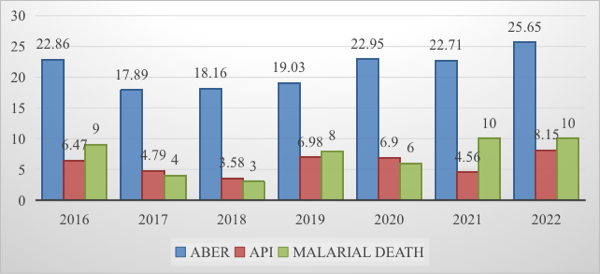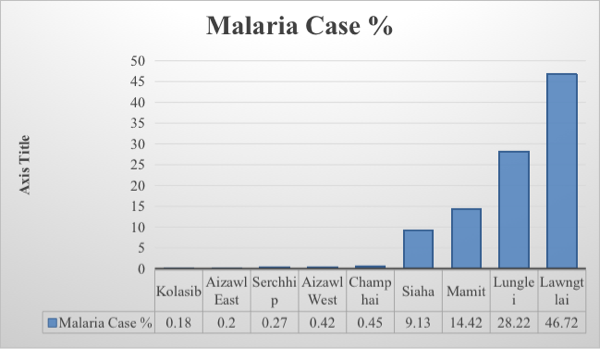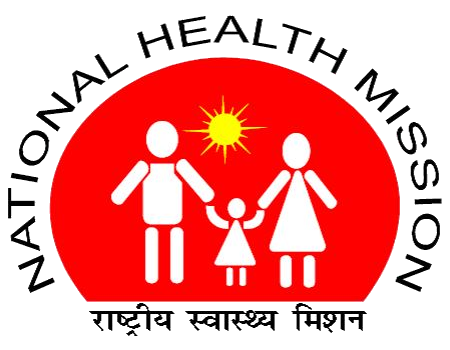National Vector Borne Diseases Control Programme (NVBDCP)
INTRODUCTION:
The control programme for Malaria began in Mizoram in the year 2005 whereas Dengue Control Programme was initiated during 2012-2013. Although much has been accomplished already during the last decades, there is so much work that lie ahead if we are to eradicate Malaria altogether. Among the six vector borne diseases Malaria still remains a major public health problem in the State. Dengue and Chikungunia is also on the rise, case incidence is higher year by year with a few fatal case of Dengue. Beside indigenous Malaria, Dengue Chikungunya,, Japanese Encephalitis possess a potential threat to the State. As Culex Mosquitoes are prevalent in the state, there is also every possibility of Acute Encephalitis Syndrome / Japanese Encephalitis (JE) occurrence in the State as suspected cases have been reported with 1 confirmed positive case reported in 2022 . Other vector borne diseases such as Kala-azar and Lymphatic filariasis have not been found in the State as of now.
Although the indigenous malaria disease incidence and death rate were on decline during the last 3 or 4 years, the year of 2021-2022 saw a steep rise in positive cases and a slight increase in mortality. This was partly attributed to scanty intermittent rainfall with warm and humid climate reported throughout the State and increased surveillance. Positive cases increased throughout the State from low endemic to high endemic Districts. There were also reports of focal outbreaks from few high endemic Districts. However, the situation was put under control and deaths were prevented as far as possible with the combined efforts of the District and the State with continued support and guidance from the Directorate of NVBDCP, New Delhi.
In this regard, the SVBDCP, Mizoram is very grateful to the Central Government for assisting the State financially and materially in the control of vector borne diseases especially Malaria and It would continue to work its best in combating the dreadful diseases and reduce the burden on health and economic development of the thousands affected by these vectors borne diseases.
VISION:
- Eliminate malaria nationally and contribute to improved health, quality of life and alleviation of poverty.
GOALS:
- Eliminate malaria (zero indigenous cases) throughout the entire country by 2030.
- Maintain malaria–free status in areas where malaria transmission has been interrupted and prevent re-introduction of malaria.
OBJECTIVES:
- Prevention of deaths due to Malaria.
- Prevention of Morbidity due to Malaria.
- Maintenance of ongoing socio-economics development.
Malaria Control activities in India
• Prior to 1953: Estimated malaria case in India –
75 millions; deaths –0.8 million
• 1953 – National Malaria Control Programme (NMCP)
• 1958: National Malaria Eradication Programme
• 1965: Cases reduced to 0.1 million
• Early 1970s : Resurgence of malaria
• 1976: Malaria cases - 6.46 millions
• 1977: Modified Plan of Operation (MPO)
• 1977: World Bank assisted Enhanced Malaria Control Project
• 1999: National Anti-Malarial Programme (NAMP)
• 2002 : National Vector Borne Diseases Control Programme (NVBDCP)
• Six Vector Borne Diseases - Malaria, Filariasis, Kala-Azar, Dengue, Japanese Encephalitis (JE) & Chikungunya.
• 2005: Global Fund assisted Intensified Malaria Control Project (IMCP)
• 2005: State Vector Borne Diseases Control Programme (SVBDCP) (Mizoram) – Malaria only
• 2006: ACT introduced in areas showing Chloroquine resistance Pf
• 2008: ACT extended to high Pf predominant districts
• 2009: Introduction of LLINs
• 2012: SVBDCP (Mizoram) - Dengue & Chikungunya added
Human Resource Status – Mizoram (as on March 2023)
· Regular:
|
Sl No |
Designation |
In Position |
|
1 |
Joint Director (Mal) cum State Programme Officer (VBD) |
1 |
|
2 |
District Malaria Officer |
9 |
|
3 |
Asst Malaria Officer |
2 |
|
4 |
Malaria Inspector |
7 |
· Contractual Staff :
|
Sl. No. |
Designation |
Allocated |
In position |
Vacant |
|
1 |
State M&E Consultant |
1 |
1 |
0 |
|
2 |
State PH& Training Consultant |
1 |
1 |
0 |
|
3 |
State Finance Consultant |
1 |
1 |
0 |
|
4 |
State IEC Consultant |
1 |
1 |
0 |
|
5 |
State Consultant (Entomology) |
1 |
1 |
0 |
|
6 |
Sr IEC Consultant (TCIF) |
1 |
1 |
0 |
|
7 |
Statistical Assistant cum Accountant |
1 |
1 |
0 |
|
8 |
Secretarial Assistant |
2 |
2 |
0 |
|
9 |
District VBD Specialist |
1 |
1 |
0 |
|
10 |
District VBD Consultant |
9 |
9 |
0 |
|
11 |
Malaria Technical Supervisor (MTS) |
26 |
26 |
0 |
|
12 |
Secretarial Asst cum Account Asst |
9 |
9 |
0 |
|
13 |
Zonal Entomologist |
1 |
1 |
0 |
|
14 |
Insect Collector |
4 |
4 |
0 |
PROGRAMME INDICATORS : MIZORAM
|
Indicator |
2016 |
2017 |
2018 |
2019 |
2020 |
2021 |
2022 |
|
Total Population (In Lakhs) |
11.7 |
11.9 |
12.01 |
12.10 |
12.24 |
12.35 |
12.54 |
|
ABER (%) |
22.86 |
17.89 |
18.16 |
19.03 |
22.95 |
22.71 |
25.65 |
|
API (per thousand) |
6.47 |
4.79 |
3.58 |
6.98 |
6.9 |
4.56 |
8.15 |
|
No of Malaria Case |
|
|
|
|
|
|
|
|
SPR (%) |
1.58 |
0.88 |
0.63 |
0.99 |
0.76 |
0.70 |
0.75 |
|
TPR(%) |
2.83 |
2.68 |
1.97 |
3.67 |
3.0 |
2.01 |
3.18 |
|
Malaria Deaths |
9 |
4 |
3 |
8 |
6 |
10 |
10 |
|
ABER: Annual Blood examination rate (per 100 of the population) API : Annual Parasitic Incidence (per 1000 of the population) SPR: Slide positivity rate, TPR: Total positivity rate
|
|
||||||
Line chart showing core indicator of Malaria (2016-2022)

National Strategic Plan (NSP) for Malaria elimination (2017 – 2022)
• Malaria is a local and Focal problem
• Districts will be the operational unit.
|
Category of Districts |
Definition |
|
Category 0: Prevention of re-establishment phase |
District/units historically considered to be without local transmission and reporting no case in last 3 years. |
|
Category 1: Elimination phase |
District/ units having API < 1 per 1000 population |
|
Category 2: Pre elimination phase |
Districts/units having API 1 and above but less than 2 API per 1000 population |
|
Category 3: Intensified control Phase |
District/units having API 2 and above per 1000 population |
Classification of Mizoram
|
Category |
Definition |
|
Category 0 : Prevention of re- establishment phase |
0 |
|
Category 1 : Elimination phase |
5 District, (Aizawl East, Aizawl West, Kolasib, Champhai, Serchhip) |
|
Category 2 : Pre-elimination phase |
0 |
|
Category 3 : Intensified control phase |
4 District, (Lawngtlai, Lunglei, Mamit, Siaha) |
|
Note : As per national Strategic plan (2017-2022), by the end 2022 Category I ie. 5 District (Aizawl East, Aizawl West, Kolasib, Champhai, Serchhip) into elimination stage and Category 3 ie. 4 District (Lawngtlai, Lunglei, Mamit, Siaha) into pre-elimination phase
|
|
District wise malaria case detection 2022

Malaria endemic state (top 3) in India and North East 2021
|
Sl No |
State |
API |
ABER |
Death |
|
1 |
Mizoram |
4.56 |
22.71 |
10 |
|
2 |
Chhattisgarh |
0.94 |
14.30 |
38 |
|
3 |
Odisha |
0.55 |
15.16 |
13 |
|
In North East India under Global fund supported states
|
||||
|
1 |
Mizoram |
4.56 |
22.71 |
10 |
|
2 |
Tripura |
2.57 |
23.57 |
4 |
|
3 |
Meghalaya |
0.12 |
11.72 |
3 |
Action taken to control/eliminate malaria
• . IRS: Indoor Residual spray by DDT done twice a year in SC>2 API.
• 2. Long lasting insecticidal nets (LLIN) distribution: In 2020, a total of 414197 LLINs distributed in all districts (village API >1).
• 3. Bed net impregnation by Insecticide: Bed net impregnation by Deltamethin have been done twice a year including army, constructions worker camp in non-LLIN coverage area in the districts.
• 4. Early diagnosis and complete treatment: Rapid diagnostic kits and anti-malaria drugs made available in all villages at free of cost.
• 5. Regular and frequent monitoring and supportive supervision have been done by state and districts staffs (regular and contractual staffs).
• 6. IEC activities: Several IEC activities ie. miking, awareness campaign to NGOs, schools etc, print & electronic media, source reduction drive, observation of anti-malaria month & day have been done.
• 7. High endemic districts i.e. Lunglei and Lawngtlai are being operated with NGO partner (CPD) to reduce malarial incidence.
• 8.Special Malaria Intervention: Special actions taken on the high endemic villages i.e Vector Control, Mass Survey, IEC/BCC activities.
• 9. State Level Task Force Committee on Malaria Elimination : Formed under the chairmanship of Principal Secretary, Gov’t of Mizoram in 2017 for seeking intersectoral convergence with different line departments under Gov’t of Mizoram. The committee is expected to conduct a quarterly meeting. Last meeting held on March 2022.
• 10. District Level Task Force Committee on Malaria Elimination : Formed under the chairmanship of Deputy Commissioner of every districts in 2017.
OBJECTIVES AND TARGETS OF DENGUE CONTROL PROGRAMME:
OBJECTIVES: Following are the specific objectives of the Mid Term Plan
· To reduce the incidence of Dengue and Chikungunya and to bring down the disease burden.
· To reduce the case fatality rate due to Dengue.
TARGETS:
· Dengue cases fatality rate to below 1%.
· Functional Sentinel Surveillance Hospital in all endemic districts/towns/cities.
· Functional Rapid Diagnostic Response team in all endemic districts/towns/cities.
The prevalence of Dengue disease is increasing year by year within the state, the state had faced a serious outbreak of Dengue especially in Aizawl city and Lunglei town areas in the year 2022 wherein the number of ELISA confirmed positive case reported was 1868 with 5 death cases, while in 2021, the confirmed positive cases reported was 83 in number with no death.
As part of mitigation plan to control Dengue outbreak in the state, SVBDCP aims to expedite strategic implementation of various activities concerning dissemination of IEC/BCC, entomological surveillance, diagnostic and other equipment supply management.
STATUS OF MIZORAM FOR DENGUE IS AS FOLLOWS:
|
Year |
Suspected Cases |
Positive Cases |
Deaths |
|
2012 |
90 |
6 |
Nil |
|
2013 |
96 |
7 |
Nil |
|
2014 |
246 |
19 |
Nil |
|
2015 |
338 |
43 |
Nil |
|
2016 |
1423 |
580 |
Nil |
|
2017 |
1015 |
136 |
Nil |
|
2018 |
867 |
68 |
Nil |
|
2019 |
853 |
131 |
Nil |
|
2020 |
623 |
67 |
Nil |
|
2021 |
420 |
83 |
Nil |
|
2022 |
5252 |
1868 |
5 |
EXECUTIVE SUMMARY
The disease situation in Mizoram State is as below:
|
Year |
Malaria Cases |
Malaria Deaths |
Dengue Cases |
Dengue Deaths |
Chikungunya Cases |
AES/ |
AES/ |
Kala-azar Cases |
Kala-azar Deaths |
Micro-filaria Rate % |
|
2012 |
9883 |
25 |
6 |
Nil |
Nil |
Nil |
Nil |
Nil |
Nil |
Nil |
|
2013 |
11408 |
21 |
7 |
Nil |
Nil |
Nil |
Nil |
Nil |
Nil |
Nil |
|
2014 |
23105 |
31 |
19 |
Nil |
Nil |
Nil |
Nil |
Nil |
Nil |
Nil |
|
2015 |
28593 |
21 |
43 |
Nil |
Nil |
Nil |
Nil |
Nil |
Nil |
Nil |
|
2016 |
7583 |
9 |
580 |
Nil |
Nil |
Nil |
Nil |
Nil |
Nil |
Nil |
|
2017 |
5715 |
4 |
136 |
Nil |
Nil |
Nil |
Nil |
Nil |
Nil |
Nil |
|
2018 |
4296 |
3 |
68 |
Nil |
10 |
Nil |
Nil |
Nil |
Nil |
Nil |
|
2019 |
8543 |
8 |
131 |
Nil |
Nil |
Nil |
Nil |
Nil |
Nil |
Nil |
|
2020 |
8349 |
6 |
67 |
Nil |
Nil |
Nil |
Nil |
Nil |
Nil |
Nil |
|
2021 |
5637 |
10 |
83 |
Nil |
Nil |
Nil |
Nil |
Nil |
Nil |
Nil |
|
2022 |
10229 |
10 |
1868 |
5 |
53 |
1 |
1 |
Nil |
Nil |
Nil |
In the State, Malaria is still a major public health problem till date. Number of confirmed Dengue case is increasing year by year. Chikungunia have been identified from 2018 with 53 confirmed case reported in 2022. JE/AES have also been identified in 2022 with 1 confirmed Positive Case. Other vector borne diseases such as Kala-azar and Lymphatic filariasis have not been found in the State as of now (2022).
Malaria is endemic (API>2) in 4 districts (out of 9) namely:
· Mamit District
· Lunglei District
· Lawngtlai District
· Saiha District
 NHM Mizoram
NHM Mizoram